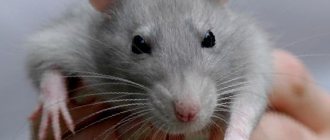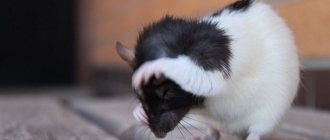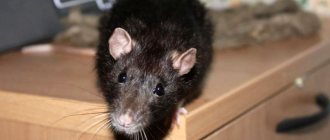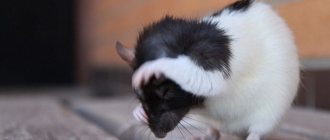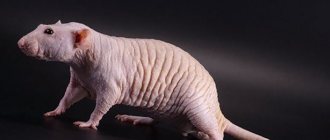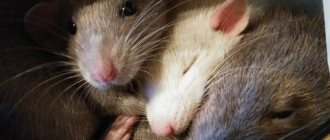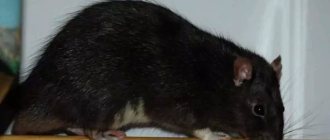An uninvited guest and a dangerous pest
- Fact:
The gray rat is distributed throughout the planet, except deserts and Antarctica. - Fact 2:
Rats live in families and can be very aggressive when strangers appear on their territory. Members of their herd are recognized by smell. - Fact 3:
Rats have exceptional survival, adaptive qualities, sharp intelligence, caution and resourcefulness. - Fact 4:
The rat reproduces rapidly, up to eight litters per year. There are up to 10 cubs in one litter.
Pasyuk is a common gray barn rat. Initially, its homeland was China, more precisely, its eastern part (at least, scientists believe so). But thanks to shipping, the rodent entered Europe on merchant ships and spread throughout the continent, and then the globe. British biologist John Berkenhout mistakenly put forward the version that the animal came to the Kingdom of Denmark from Norway, so the pasyuk received the scientific name “Norwegian rat”. This happened in 1769, when there was no trace of the pest in the Norwegian territories.
This is one of the most unpleasant rodents that causes damage to people. Plus a carrier of pathogens of serious diseases. Pasyuk is a threat to humans, their pets, livestock and poultry, garden plantings, and garden trees. The damage to agriculture amounts to six or even seven figures. It is not surprising that entire research institutes are working on developing ways to fight animals.
Description of rats
Rats are the most common mammals of this family. They can be found anywhere on our vast Planet. Despite their belonging to the family, rats differ from mice not only in appearance, but also in their behavior. In addition, rats are much larger in size compared to mice. Their body is more developed, the muzzle is more elongated, and the nose is more elongated. The rat's eyes are relatively small, like beads.
In case of danger, these rodents begin to secrete a strong-smelling secretion, thanks to which the rest of the family becomes aware of the danger. Despite their size, their body structure is such that they are able to fit through small holes, which make up about 25 percent of the total body girth.
Appearance
These representatives of the mouse family have a body structure characteristic of rodents, which is quite powerful and oval in shape. Adults grow from 8 to 30 cm in length, while their weight can range from 40 to 510 grams. There are species that differ markedly from their counterparts, depending on species characteristics, as well as on their habitat.
The rat's muzzle is pointed and elongated, with small eyes and ears. In most varieties, the tail is completely naked, covered with scales and sparse hairs. Black rats are distinguished by the fact that their tail is completely covered with thick black hair. As a rule, rats have a rather long tail, the size of which is commensurate with the length of the body, and sometimes exceeds this indicator. Although it should be noted that there are also short-tailed rats.
The jaws of this rodent are armed with pairs of incisors, which are noticeably larger than the teeth. The molars are arranged in dense rows, which allows the rodent to quickly and actively grind food. Between the incisors and molars, you can observe an area where teeth do not grow. Rats do not have fangs, although they are omnivorous mammals. A rat's incisors are constantly growing, which requires constant grinding, otherwise the animal will not be able to fully close its mouth. This is due to the fact that the incisors do not have roots. The front part of the incisors is much stronger than the back part, since it is covered with durable enamel. As a result, the grinding of the incisors does not occur evenly, and over time they acquire a chisel-like shape. The teeth of these animals are so strong that the rat can easily cope with obstacles in the form of brick or concrete, although they were originally intended by nature to obtain exclusively plant food.
Interesting to know! Rats have a fairly thick and dense coat, thanks to well-defined guard hairs. The color of the coat can be different, both grayish-brown and dark gray, with the presence of various reddish, orange or yellow shades.
Although rats have calluses on their paws, they are poorly developed. Due to the presence of calluses, many animals move quickly on any surface. This deficiency in rats is compensated for by tenacious and mobile toes. Therefore, rats can lead both a terrestrial and semi-arboreal way of life. They easily move through trees, so they build their nests in tree hollows or use ready-made nests of other animals and birds, left by them for various reasons.
Behavior and lifestyle
Rats are considered incredibly agile living creatures and incredibly resilient. For animals of this size, they run well, picking up speeds of up to 10 km/h, while overcoming obstacles up to 1 meter high. These rodents travel an average of 12 kilometers every day. They are excellent swimmers and divers, so they can easily catch fish. Without harming their health, rats can stay in water for up to 3 days, or even more.
Burrows abandoned by other animals, as well as artificial shelters and nests of various birds can serve as a refuge for rodents. If necessary, the rat is able to dig a hole for itself on its own.
Rats can easily lead an isolated lifestyle or form family groups, as well as territorial communities. A colony may contain several hundred individuals, which are subordinate to one dominant male and several dominant females. Each such group is capable of controlling an area of about 2 thousand square meters.
Rats have poor vision, characterized by a small viewing angle of about 16 degrees, so the rat constantly rotates its head in different directions, studying the space around it. It is believed that rats perceive the surrounding space in gray tones, and continuous darkness appears as red.
Interesting fact! The rat has a well-developed sense of smell and hearing, so animals are able to hear sounds with a frequency of up to 40 kHz.
Rodents are capable of distinguishing odors at short distances. It should be noted that they can withstand radiation up to 300 roentgens per hour without any problems.
How long do rats live?
This indicator is directly related to species. If we take gray rats, then under natural conditions their average life expectancy is no more than one and a half years, although some individuals live up to 3 years.
If you take black rats, they live less than a year. When living in laboratories at various scientific institutions, rats live 2 times longer. The Guinness Book of Records contains information about the oldest rat, which managed to live for almost 8 years.
TOP 5 scary facts about rats
Sexual dimorphism
Upon reaching one and a half months of age, the animals’ sexual characteristics are fully formed. To determine whether it is a female or a male, it is enough to raise the tail to determine the structure of the animal’s reproductive system.
Males differ from females:
- By the presence of fairly large testicles, which can be detected if you lift the animal's tail.
- Males do not have nipples on their bellies like females. They are arranged in 2 rows.
- In males, the distance between the anus and the urethra is slightly greater.
- Males are stronger and more powerful, and they are also larger in size.
- Males have a pear-shaped body, while females have a graceful and elongated body shape.
- Males have denser and tougher fur, while females have smooth, soft and silky fur.
- Males are less aggressive than females.
- The urine of males has a sharper and more unpleasant odor.
As for newborn rat pups, it is almost impossible to determine their gender. Although experts know that males who have just been born have small spots between the anus and genitals. Over time, testicles appear in place of these spots.
Important point! According to experts, one pair of adult individuals in a couple of years is capable of producing offspring of up to 6 thousand cubs. Rats, having reached puberty, reproduce no less actively.
Capabilities
The gray rat lives up to 3 years, but this is only if it is not sick, there is plenty of food, and there are no enemies. Usually such an idyll occurs only in laboratories or in home care. In nature, rats rarely live longer than one and a half years. Their abilities are unique. The fact that they anticipate earthquakes is not particularly surprising, because many animals can do this. But the fact that rats can predict where a shell will land is truly amazing. During the war, people, knowing about this talent of rodents, fled to those huts where the rats were hiding. A unique incident occurred in a market in France. It was moved to a new place, and already a day or two before, all the market rats had moved there, although, of course, no one informed them about this. Scientists have found that gray rats make about 5 thousand sounds, that is, they have their own “alphabet”.
These animals remember our faces and feel our character. They are able to pick up the slightest noise even in the 40 kHz range, which is used in electronic repellers. They distinguish two colors - blue and greenish. They dream, love classical music, and know how to laugh.
Types of rats with photos and names
The genus “Rats” includes several dozen species that represent certain groups. Some of the species are considered extinct today.
Species groups include:
- Norvegicus;
- Rattus;
- Xanthurus;
- Leucopus;
- Fuscipes.
It makes sense to focus on the following types:
Gray rat, or Pasyuk (Rattus norvegicus)
It is considered the largest representative of this species. Pasyuki are found in quite numerous groups on the territory of Russia. The species was introduced accidentally, but is a true synanthrope. Pasyuki grow up to a maximum length of 25 cm, with a maximum weight of almost 400 grams. The tail is relatively short, the muzzle is wide and has a blunt ending. Juveniles are gray in color, and with age the coat acquires a noticeable reddish tint. The guard hairs are shiny and long. The belly is lighter in color.
Black rat (Rattus rattus)
It is slightly smaller in size compared to the gray rat. Its muzzle is narrower, its tail is longer and its ears are large and rounded at the end. Rats grow up to a maximum of 21 cm and weigh no more than 300 grams. The tail of these rodents is covered with thick hairs. The main color of the animal is black-brown with a greenish tint, which extends more to the back area. The sides of the rat are lighter, and the belly is dark gray or ashy. Some individuals have a color similar to the gray rat, but their back is lighter, yellowish in color.
Small rat (Rattus exulans)
This rodent belongs to a species that is also quite widespread. The species differs from other species in its small (comparatively) body size. The maximum length of the body is in the range of 11-14.5 cm, and the maximum weight averages 70 grams. This rodent has a compact body, a sharp muzzle, large ears and a brown coat.
Long-haired rat (Rattus villosissimus)
The name itself suggests that the rodent has long hair. In addition, this species has a high reproductive rate. Adults grow up to 19 cm in length, with a tail length of about 15 cm. The average weight of the animal is in the range of 120-150 grams, depending on gender.
Kinabuli rat (Rattus baluensis)
It belongs to a very unique species that has a symbiotic relationship with the tropical carnivorous plant "Nepenthes Raja". This rather large plant secretes a sweet secretion, which attracts the rat. In return, the rats leave their excrement for the plant.
Turkestan rat (Rattus pyctoris)
It is a typical inhabitant, which is distributed in countries such as Afghanistan, Nepal, China, India, Pakistan, Iran, Uzbekistan and Kyrgyzstan. Adults grow up to 17-23 cm and their tail length is almost equal to their body length. The animal's abdomen is yellowish-white, and the back area has a reddish-brown tint.
Silver-bellied rat (Rattus argentiventer)
This variety is not distinguished by its wide distribution on the planet. Its coat color is characterized as ocher-brown, with the presence of a small amount of black hairs. The belly is colored gray, while the sides are light and the tail is brown. The length of adult individuals can reach 40 cm or slightly more, weighing up to 200 grams maximum.
Furry-tailed rabbit rat (Conilurus penicillatus)
It has an average body size, reaching 22 cm. The animal weighs about 185 grams. Often in individuals the tail length is longer than the body length. A tuft of hairs grows at the end of the tail. The color of the dorsal part is grayish-brown, with black hairs. The hind legs and belly are almost white. The coat is quite hard and not very thick.
Soft-furred rat (Billardia meltada)
Refers to typical representatives living in countries such as Nepal, India, Sri Lanka, Bangladesh. The length of adult individuals is in the range of 90-190mm, while the length of the tail can be in the range of 70-180mm. The species is distinguished by the fact that it has soft and silky fur, grayish-brown on the back and white on the belly. The upper part of the tail is dark gray.
Tan Rat (Rattus adustus)
This species became known a little over 70 years ago and was classified as an exceptional species. As far as is known, the species received its name due to the exceptional color of its coat.
Interesting fact! Rodents communicate with each other using ultrasonic waves. Their hearts beat at a rate of 300-500 beats per minute.
5 Biggest Rats in the World
Preventive protection measures
Rats are primarily attracted to food, water and shelter in the home. Therefore, it is necessary to limit access to each component.
Reduce food sources: Trash cans should be covered and emptied regularly. Bird food should be in specially designated feeders. Rats can even feed on bird excrement, so it is necessary to create separate feeding areas.
Reducing water sources: eliminating basement leaks; removal of direct sources of water, such as tanks, barrels from the surrounding area; eliminating the possibility of basement flooding.
Eliminate entry points: sealing holes and cracks in basements.
Natural habitats
Rats can safely be called animals that appeared on earth even before man appeared on it. They are found in almost all corners of our Earth. Depending on the species, they are found both within the Euro-Asian continent and within other continents, including Australia, the Malay Archipelago, New Guinea, etc.
Yet their habitat is limited to northern, cold regions. Within central Russia there are no more than 2 species of rats - gray and black. If necessary, a rat can cover up to fifty kilometers in one day.
Rats are mammals that easily adapt to fairly difficult living conditions, which is why rats are often found at abandoned research stations in Antarctica.
Prevention measures
To ensure that rats are as little interested in your home as possible, you need to monitor its condition and follow the following recommendations:
- do not leave trash and keep order in the area around the house;
- eliminate the presence of even the smallest through holes in the walls or roof;
- get rid of sources of standing water on the site;
- do not leave leftover food outside at night;
- get a cat or dog of a breed that is excellent at hunting rodents.
Rat diet
Rats are considered omnivorous rodents, but their diet depends on their living conditions, which is directly related to their lifestyle. Each animal needs about 25 grams of feed per day. At the same time, the lack of food is very difficult for animals to tolerate. As a rule, after three days, without food, the animal dies. The absence of water is even more difficult for animals. To maintain normal functioning, rats need to drink up to 35 ml of water per day.
The physiological characteristics of rats are that they are more adapted to the consumption of food items with a high protein content. Therefore, it is quite natural that they simply need animal food. Gray rats never prepare food for future use. The diet of black rats is mainly related to plant foods.
Black rats eat:
- Nuts and seeds of various plants.
- Chestnuts.
- Cereal grains.
- Fruits of various plants.
- All kinds of greens.
When rats settle not far from human habitation, they feed on any food they have access to. Those rats that live far from human habitation are able to feed on small rodents, mollusks, amphibians, bird eggs and their chicks. Those species that live on the coast feed on gifts from the seas and oceans washed ashore by waves.
Important point! Rats have an excellent sense of fullness, so they never overeat, even when very hungry.
Lifestyle
Common rats lead a crepuscular lifestyle. Active from 7 pm to 8 am , the maximum peak occurs at 20-22 hours.
They can crawl out of their shelters during the daytime if necessary. They live in groups or colonies, aggressively protecting their territory from strangers.
Recognizes pack members by smell. In nature, they serve as shelters : holes, stumps, snags, ruined nests. In the city, they often live in garbage dumps, landfills, basements, and sewers.
They feed on plant foods , fish and meat, grain, and any food waste.
Many animals will envy the stamina and vitality of pasyuks. They have high adaptive capabilities, mental flexibility, excellent diving and swimming, jumping up to 80 cm, and when moving around the territory they reach speeds of 10-12 km/h.
Reproduction and offspring
Rats, regardless of species, reproduce at a very high rate. This is also due to the fact that they quickly reach puberty. Females bear their offspring over short periods of time. A sexually mature female can mate every 5 days, with the exception of the period of pregnancy.
Within 1 year, each adult female gives birth to up to 4 dozen rat pups, while pregnancy lasts about 3 weeks. Having reached the age of one and a half years, females are approaching the period of menopause, which at the initial stage appears irregularly, and then the female is no longer able to reproduce.
Before the end of the pregnancy period, the female tidies up her nest. She lines the bottom of the nest with soft grass. Sometimes the female digs a new hole, after which she takes care of its arrangement. Often in this nest the female contains food reserves, thanks to which she can stay with the newborns for a long time without any problems.
Depending on the species, female rodents can reproduce from 8 to 15 young at a time. Rats are born naked, blind and deaf, with completely closed ear canals, and without a well-functioning thermoregulation system.
After birth, they are not able to independently remove processed components. Therefore, the female constantly licks her stomach with it, as if giving a massage, which helps to activate metabolic processes. The cubs feed on mother's milk, the fat content of which reaches 9 percent. Unfortunately, rats are capable of destroying their offspring, and males are more prone to this. As for females, they can eat dead cubs or very weak ones.
Interesting to know! Domestic rats can mate with black rats, but their offspring do not survive, and quite often the mother's body completely rejects the embryos, and often non-viable offspring are born.
After some time, fur appears on the body of the rat pups, and after a week they begin to see and hear. On the ninth day, the first incisors erupt in the juveniles. After 3 weeks, the young offspring independently explore the nearby territory, and after another week they are ready for independent life. They become fully mature by the age of one year.
How to force the management organization to destroy rodents in the house?
It should be kept in mind that even if one rat was spotted in an apartment, this is a sure sign that a colony of rodents is already living in the house. Since rats almost never settle in apartments, but come to them only in search of food.
The management company is responsible for the maintenance of common property, ensuring the safe living of citizens, and compliance with sanitary standards. Her responsibilities include ensuring regular deratization and disinfestation of common areas, which include basements, technical rooms, stairs and landings, elevators and elevator shafts, and common corridors.
So the first authority to contact if rats appear in the house is the management company. Residents need to write a statement in which they demand pest control, referring to regulations, the Decree of the State Construction Committee and the Rules for the maintenance of common property.
The application is submitted to the Criminal Code, receives a mark of acceptance and waits for a response within the 10 days required by law. After this period, representatives of the management organization are obliged to provide a response and set deadlines for carrying out measures to exterminate rodents.
Population and species status
Since the beginning of the third millennium, black rat populations have declined markedly and become fragmented. According to experts, black rats have begun to be replaced by more fertile gray rats (pasyuki). And yet, despite the high fertility, rat populations do not go beyond the “Red Line”, since their numbers are controlled by a number of important factors.
Firstly, the number of these animals directly depends on the availability of food and shelter. Lack of food immediately leads to a decline in population. In addition, there are special rat control services. The number of these animals is constantly declining as a result of certain diseases, as well as hunting by many predators. Therefore, despite their high fertility, which leads to constant surges in their numbers, natural factors, as well as rat control services, are doing their job.
Today, most species of rats are not even close to the risk zone, although there are very rare species that are protected. As a rule, the number of rare species largely depends on the life activity of people, who are developing more and more new territories that are related to the natural habitat of these species.
Franklin Island is home to a very rare species of “House Rats.” Due to the fact that the species lives in a limited area, it is classified as an endangered species. Currently, only about 2 thousand individuals live in this territory. Annual deforestation and fires can reduce kangaroo rat populations.
How to get rid of a pest
Gray rat.
Getting rid of Gray rats is quite difficult, since this rodent is very prolific and can produce up to 6-8 litters per year. There are a number of methods that will help expel them from the site or from the house:
- toxic chemicals;
- mechanical traps;
- traditional methods.
Follow the links to read in more detail about how to expel rats from your property or barn.
Danger to humans
The confrontation between humans and rats has lasted for thousands of years. In our time, such a struggle has received an official name - rodent control. Despite its notoriety in Europe and many other countries, including the Americas, in some countries of the East this rodent received the status of a divine animal that symbolizes wealth, wisdom, prosperity, etc. The negative image of this rodent is associated with several plague epidemics in Europe, which were carried by rats.
Important point! Rats are involved in serious economic losses that are associated with spoilage and consumption of various types of goods, both food and other purposes. These rodents damage the insulation of electrical networks, which leads to fires that claim the lives of many people, not to mention damage to property.
Some species of rats cause serious damage to agricultural crops because they simply destroy crops. Therefore, in such conditions, people resort to various methods of protecting crops from rodent invasion. In some cases they are simply scared away, and in others they are physically destroyed. Currently, rats pose a serious threat to the health of all humanity, since these rodents carry pathogens of dangerous diseases. The danger of their vital activity also lies in the fact that these rodents are able to completely unnoticedly penetrate into a human home through sewage and ventilation systems.
Despite the constant and serious fight against rats and other rodents, it has not yet been possible to completely destroy them, but it is still possible to control the populations of these pests.
Experts have established certain norms for deratization, which is associated with the optimal percentage of freeing the territory from rodents.
Therefore it is considered:
- 80% – the result is satisfactory.
- 90% is a good result.
- 95% is an excellent result.
In this regard, it is generally accepted that the task of special deratization services is to maintain in a certain area an acceptable percentage of rodents that would not be able to cause much damage to human life.
What to do if the management company or HOA ignores the need to combat rodents?
If rats are found in an apartment, entrance or basement, the management company has received a statement from the residents, but ignores it, the next step must be taken. Residents of the house can complain to Rospotrebnadzor, the Housing Inspectorate, and the prosecutor's office. The complaint should state the situation, attach a copy of the application, the response of the management company (or note that there was no response) and demand that an inspection be carried out against the management company, as well as oblige it to carry out the required deratization measures.
Such applications are considered within 30 days. If, based on the results of the inspection, the fact of violations is established, this threatens the management company with serious problems, including revocation of the license.



